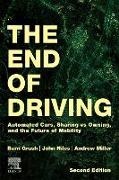Mehr lesen
The End of Driving: Automated Cars, Sharing vs Owning, and the Future of Mobility, second edition, examines the complex intersection of vehicle automation, public policy, and social change. It analyzes two competing models for the deployment of driving automation-privately owned, automated, or highly automated vehicles versus on-demand driverless vehicles (robotaxis)-and argues that while robotaxis could offer superior urban mobility, achieving this outcome requires deliberate policy choices. Drawing from early deployments through 2025, this book explores how automated vehicles could advance public interests, including social equity, environmental sustainability, and urban liveability; but only with thoughtful system design and implementation.
This thoroughly updated second edition examines the psychological factors influencing transportation choices that will make private vehicle ownership persist; explores the challenges of roads where human drivers and self-driving vehicles will operate simultaneously; and proposes innovative approaches like flexible on-demand transit and targeted financial incentives to encourage shared mobility. This book introduces new concepts, like zero-car-ownership communities, and changes to urban design centered on access to automated transportation.
Instead of forecasting specific timelines for automated-driving milestones, this book engages in ‘backcasting’, identifying how to achieve a desirable future.
The End of Driving: Automated Cars, Sharing vs Owning, and the Future of Mobility makes a compelling case that while private vehicle ownership is likely to remain dominant, a transportation system with greater shared mobility is still possible and preferable. Achieving it, however, will require strategic policy interventions to overcome deeply ingrained behavioral patterns and market forces that favor ownership.

